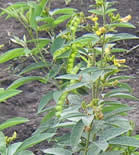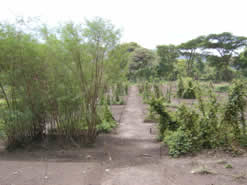መግቢያ
 Ethiopia is known with great diversity of forage grasses, legumes and browse species indigenous to the country. These biological resources are the primary sources of animal feed which support about 20% of the Gross Domestic Product (GDP) of the country, and the potential of the indigenous forage and pasture gene pool for improvement of the livestock feed. However, despite the importance, serious genetic erosion is taking place due to both natural and man-made factors. Moreover very limited attention has been given in the past for the collection, conservation, characterization, evaluation and sustainable use of the resource.
Ethiopia is known with great diversity of forage grasses, legumes and browse species indigenous to the country. These biological resources are the primary sources of animal feed which support about 20% of the Gross Domestic Product (GDP) of the country, and the potential of the indigenous forage and pasture gene pool for improvement of the livestock feed. However, despite the importance, serious genetic erosion is taking place due to both natural and man-made factors. Moreover very limited attention has been given in the past for the collection, conservation, characterization, evaluation and sustainable use of the resource.
Field gene bank is one of the techniques in the strategy for plant genetic conservation. It is an ex situ method where genetic variation is maintained away from its original location and samples of a species, subspecies or variety are transferred and conserved as living collections. Field gene bank is the most common method of conserving genetic resources of species with recalcitrant seed and vegetatively propagated plants.
As part of the ex situ conservation program the forage and pasture genetic resource department established field gene bank at Wendo Genet in half a hectare area in 2004.
The Field Gene Bank
Wendo Genet Forage and Pasture Plants Field gene Bank (FGB) is located around 264 km south of Addis Ababa. Geographically it is located at 070 05’25” N and 0380 38’04” E. The FGB is found in moist weina dega, agro ecological zone of Ethiopia, soil type is fertile black forest soil and the altitude is around 1830 meters above sea level. Currently the site is established in an area of 91.8 X 55 (0.5 ha) with an opportunity to expand in the future.

Though the field gene bank was originally designed for conservation of vegetatively propagated forage and pasture plants especially for grass species currently it is used for seed increase and characterization of herbaceous legumes and some browse trees.
Since its establishment in 2004, in different planting season a total of 326 accessions from 25 forage legume and 2 browse species were planted in the FGB, of which 252 accessions seed were increased, characterized for important traits and conserved for long term in the gene bank. Currently there are 173 accessions of herbaceous legumes and 10 grass species in plot base at the site.
